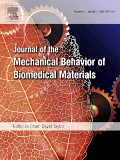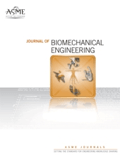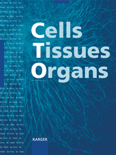
Biomaterials and Biomechanics in Bioengineering
Scope & Guideline
Shaping the Future of Biomaterials and Biomechanics.
Introduction
Aims and Scopes
- Biomechanical Analysis:
The journal extensively covers the mechanical analysis of biological systems and biomedical devices, utilizing methodologies such as finite element analysis (FEA) to assess their performance under various conditions. - Material Behavior Studies:
Research on the behavior of biomaterials under physiological conditions is a central theme, including studies on their mechanical properties, durability, and interactions with biological tissues. - Innovative Biomaterials Development:
The journal highlights advancements in the design and application of new biomaterials, particularly those that enhance the performance of medical implants and devices. - Interdisciplinary Research:
A significant focus is on interdisciplinary approaches that combine principles from engineering, biology, and materials science to address complex problems in bioengineering.
Trending and Emerging
- Finite Element Analysis (FEA):
There is a significant increase in the use of finite element analysis as a tool for understanding the mechanical behavior of biomaterials and devices, showcasing its importance in predictive modeling and design optimization. - Advanced Biomaterials for Joint Applications:
Research focused on advanced biomaterials, such as PEEK (polyether ether ketone), for joint replacement applications is on the rise, reflecting a trend towards materials that offer better biocompatibility and mechanical performance. - Fluid-Structure Interaction Studies:
Emerging interest in the interaction between fluids and biomaterials, particularly in complex biological environments, points to a growing recognition of the importance of multi-physics approaches in bioengineering research.
Declining or Waning
- Traditional Material Studies:
There has been a noticeable decrease in research centered around conventional biomaterials, such as metals and ceramics, as the focus shifts towards innovative and composite materials that offer enhanced functionalities. - Basic Theoretical Models:
The use of basic theoretical models in biomechanical studies seems to be waning, with a preference for more sophisticated computational methods, such as finite element modeling, which provide deeper insights into material behavior. - Clinical Application Studies:
Research directly translating findings into clinical applications appears to be less frequent, indicating a shift towards more experimental and theoretical studies that may not directly address immediate clinical needs.
Similar Journals

Materials Today Bio
Bridging disciplines to transform biomedical engineering practices.Materials Today Bio, published by Elsevier, is an esteemed open-access journal dedicated to advancing the fields of bioengineering, biomaterials, and biomedical engineering. Since its inception in 2019, this journal has quickly made a name for itself, currently ranked Q1 in multiple categories including Bioengineering, Biomaterials, and Biotechnology, reflecting its exceptional quality and relevance in the rapidly evolving landscape of bio-related sciences. With an impressive Scopus ranking positioning it in the top 25% of its categories, Materials Today Bio provides a vital platform for researchers and professionals to share cutting-edge discoveries and innovative applications that bridge the gap between materials science and biological studies. Accessible to a global audience, this journal not only fosters collaboration among the scientific community but also aims to highlight significant advancements in cell and molecular biology, making it an indispensable resource for students and seasoned experts alike. The journal's commitment to open access since 2019 underscores its dedication to disseminating knowledge widely, ensuring that crucial findings reach those who can benefit from them the most.

Journal of the Mechanical Behavior of Biomedical Materials
Advancing the Frontiers of Biomedical InnovationJournal of the Mechanical Behavior of Biomedical Materials is a leading academic publication dedicated to the intersection of mechanical engineering and biomedical innovation. Published by ELSEVIER in the Netherlands, this journal, which holds a solid presence within Q2 in Biomaterials and Biomedical Engineering, and Q1 in Mechanics of Materials as of 2023, features high-impact research with a measurable Scopus ranking that places it in the top tier of its fields. With an impressive percentile performance—82nd in Mechanics of Materials and 73rd in Biomedical Engineering—this journal serves as a vital resource for researchers, students, and professionals seeking to enrich their understanding of the mechanical behaviors of biomaterials and their applications. Spanning converged years from 2008 to 2024, it provides access to a wealth of pioneering research that advances the knowledge essential for the development of innovative biomedical applications. Engage with cutting-edge studies and broaden your expertise in the rapidly evolving realms of biomaterials and biomedical engineering through this authoritative publication.

JOURNAL OF BIOMECHANICAL ENGINEERING-TRANSACTIONS OF THE ASME
Catalyzing Interdisciplinary Discoveries in BiomechanicsJOURNAL OF BIOMECHANICAL ENGINEERING-TRANSACTIONS OF THE ASME, published by the esteemed ASME (American Society of Mechanical Engineers), has been a leading platform for scholarly communication in the fields of biomedical engineering and physiology since its inception in 1977. With a focus on advancing the understanding of the mechanics of biological systems, this journal serves as an invaluable resource for researchers, professionals, and students alike. Despite its current 2023 quartile ranking of Q3 in both Biomedical Engineering and Physiology (Medical), it provides a critical forum for innovative research and comprehensive reviews that contribute to ongoing developments in biomechanical engineering. The journal's contributions span a wide array of topics, reinforcing its significance in bridging the gap between engineering principles and biological applications, thus fostering interdisciplinary research aimed at enhancing human health. The journal is accessible in both print and electronic formats, ensuring wide dissemination of its impactful findings.

Journal of Theoretical and Applied Mechanics
Fostering Academic Dialogue in Mechanics Since 2006Journal of Theoretical and Applied Mechanics, published by the Polish Society of Theoretical and Applied Mechanics, stands as a leading platform for disseminating cutting-edge research in the realms of theoretical and applied mechanics. With its ISSN 1429-2955 and E-ISSN 1429-2955, this Open Access journal has been fostering academic dialogue since 2006, making knowledge readily accessible to researchers and practitioners alike. Based in Warsaw, Poland, the journal encompasses a wide breadth of topics within mechanics, appealing to a diverse readership including researchers, professionals, and students. The journal's current Scopus ranking places it within the 30th percentile of the field, emphasizing its relevance and contribution to the discipline. As it converges from 2007 to 2024, the Journal of Theoretical and Applied Mechanics is pivotal for those seeking to advance understanding and innovation in mechanical engineering and mathematics, making it an essential resource for anyone involved in these critical areas of study.

Biophysics Reviews
Navigating the Frontiers of Biophysics and BiotechnologyBiophysics Reviews, published by AIP Publishing, is an emerging journal in the field of biophysics, aiming to bridge the gap between fundamental biophysical research and applied sciences. With an ISSN of 2688-4089, this journal provides a critical platform for the dissemination of high-quality reviews covering the interplay between biochemistry, molecular biology, biotechnology, and materials science. As of 2023, it provides essential insights for researchers and professionals interested in understanding biomolecular processes at a physical level. Although the journal is not currently open access, it is making strides in establishing its impact in the competitive landscape, as indicated by its Scopus rankings in various related fields, including biochemistry and bioengineering. With a focus on enhancing collaborations among scientists and practitioners, Biophysics Reviews is poised to become a vital resource for anyone looking to deepen their understanding of how biophysical principles can be applied to solve complex biological challenges.

Journal of Biomimetics Biomaterials and Biomedical Engineering
Pioneering Research in Biomimetics and Biomedical EngineeringThe Journal of Biomimetics Biomaterials and Biomedical Engineering, published by TRANS TECH PUBLICATIONS LTD, stands at the forefront of interdisciplinary research that merges biology with engineering to address real-world challenges in healthcare and material science. Since its inception in 2014, the journal has contributed valuable insights into the development of innovative biomaterials and biomedical applications, showcasing research excellence in its fields, including biotechnology and bioengineering. With an ISSN of 2296-9837 and an E-ISSN of 2296-9845, this journal provides a platform for both emerging and established researchers to disseminate their work, fostering knowledge transfer across the global scientific community. Currently positioned in the Q4 quartile across categories such as Bioengineering, Biomedical Engineering, and Biotechnology, it aims to enhance its impact through open-access policies and rigorous peer-review processes. With its headquarters in Germany, the journal welcomes diverse contributions from around the world, shaping the future of biomimetic technologies and advancing our understanding of complex biomedical systems.

APL Bioengineering
Empowering Discoveries in Bioengineering and BeyondAPL Bioengineering is a premier open-access journal published by AIP Publishing, dedicated to advancing the field of bioengineering and its interdisciplinary applications. Established in 2017, this journal serves as a vital platform for researchers, professionals, and students interested in the critical intersections of bioengineering, biomaterials, biomedical engineering, and biophysics. With an impressive impact factor and consistent rankings in the Q1 category across multiple domains, including biochemistry and materials science, APL Bioengineering has positioned itself among the top journals in its field. The journal aims to publish innovative original research, comprehensive reviews, and insightful case studies that further the understanding and application of bioengineering principles. Since its inception, APL Bioengineering has fostered a community of thought leaders, providing open access to ensure broad dissemination of knowledge and advancements that underpin the future of biomedical innovation.

PERIODICA POLYTECHNICA-MECHANICAL ENGINEERING
Fostering Innovation in Mechanical Engineering ResearchPERIODICA POLYTECHNICA-MECHANICAL ENGINEERING, published by the Budapest University of Technology and Economics, is a distinguished open access journal that has been committed to advancing the field of mechanical engineering since its inception in 1969. With an E-ISSN of 1587-379X, this journal makes a significant contribution to the dissemination of cutting-edge research, currently holding a Q3 ranking in the prestigious Scopus category for Mechanical Engineering. Offering a platform for researchers to share innovative findings and methodologies, PERIODICA POLYTECHNICA serves as a vital resource for professionals, scholars, and students looking to stay abreast of the latest developments in mechanical engineering. With an open access format established since 1999, it ensures high accessibility to valuable knowledge, enabling a global audience to engage with pioneering studies while enhancing collaboration and knowledge-sharing within the field.

International Journal of Bioprinting
Transforming ideas into tangible solutions through bioprinting.The International Journal of Bioprinting, published by Accscience Publishing, is a pioneering platform dedicated to advancing the field of bioprinting and its applications in biotechnology and manufacturing engineering. Established in 2015, this journal has quickly gained recognition, reflected in its prestigious placements within the Q1 and Q2 quartiles across various categories, including Industrial and Manufacturing Engineering, Biotechnology, and Materials Science. With *Scopus rankings* placing it in the top percentiles of its respective fields, the journal aims to provide researchers, professionals, and students with cutting-edge insights and innovative methodologies that drive the evolution of bioprinting technologies. The International Journal of Bioprinting not only facilitates access to high-quality, peer-reviewed research articles but also supports the rapidly growing community dedicated to the exploration of bioprinting applications, making it an essential resource for those on the forefront of this exciting scientific frontier.

CELLS TISSUES ORGANS
Illuminating the Path to Understanding Biological Complexity.CELLS TISSUES ORGANS is a renowned academic journal published by KARGER, focusing on pivotal research within the fields of Anatomy and Histology. Based in Switzerland, this journal has been disseminating influential scientific findings since 1889, contributing to our understanding of cellular structures and tissue functionality. With a current impact factor that places it in the Q2 quartile for both disciplines, it serves as a vital resource for researchers, professionals, and students seeking to stay abreast of significant advancements and discussions in these areas. The journal embraces an Open Access model, ensuring that high-quality, peer-reviewed articles are freely available, thus enhancing visibility and accessibility of critical research. As it continues to foster scholarly communication and innovation up to 2024, CELLS TISSUES ORGANS plays a crucial role in shaping the future of biological sciences and medical research.